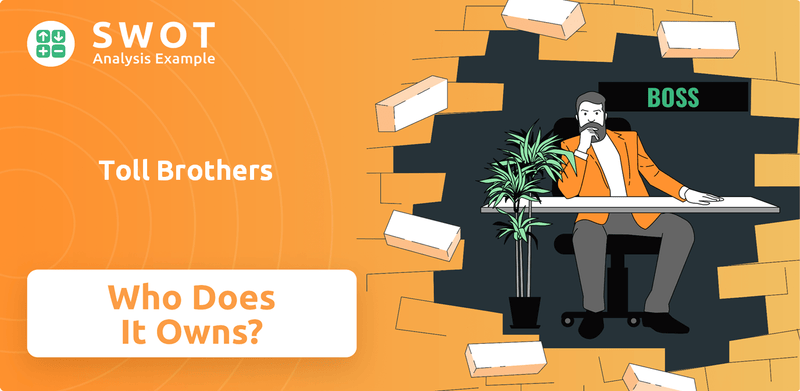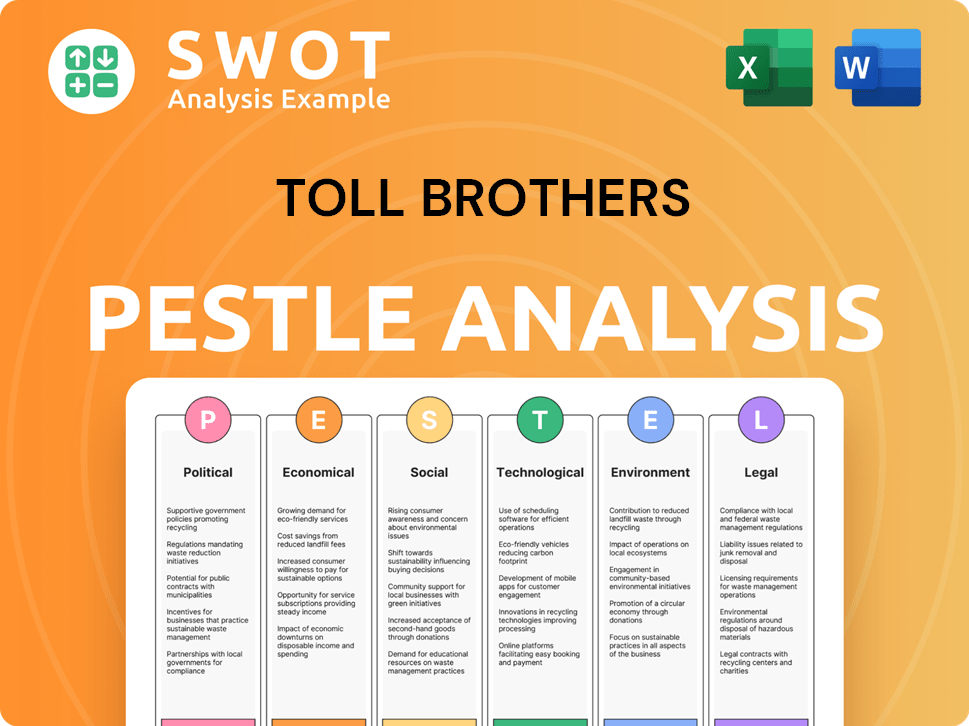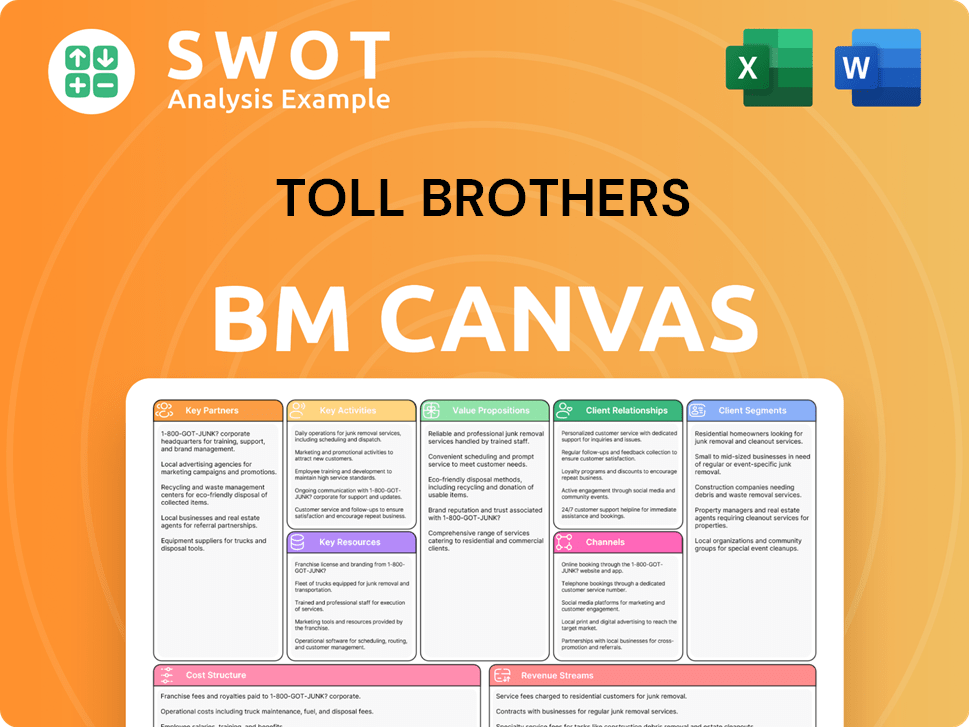Toll Brothers Bundle
Who Really Controls Toll Brothers?
Understanding the ownership structure of any company is crucial, but especially so for a major player like Toll Brothers. Knowing who owns Toll Brothers reveals the driving forces behind its strategic decisions, financial performance, and future growth. This knowledge is essential for anyone looking to invest in or understand the luxury homebuilding market. Uncover the key players and their influence in this detailed analysis.

Toll Brothers, a publicly traded company since 1986, presents an intriguing ownership landscape. The company's history, from its founding by the Toll brothers to its current status as a Fortune 500 company, shapes its present. This exploration into Toll Brothers SWOT Analysis will help you understand the impact of its ownership on its operations and the overall market. This analysis will delve into the roles of major shareholders, the influence of its executives, and the trajectory of its stock.
Who Founded Toll Brothers?
The story of Toll Brothers, a prominent name in luxury home building, began in 1967. The company was co-founded by brothers Robert I. Toll and Bruce E. Toll in Pennsylvania. This marked the start of what would become a significant player in the real estate market.
Robert Toll, who passed away in 2022, brought a legal background to the venture, while Bruce Toll's expertise was in accounting. Their father, Albert, a home builder, inspired them to see the potential in the new home industry. At the time of founding, Bruce was 26 and Robert was 27.
The company's journey from a private entity to a publicly traded one is a key part of its history. The initial public offering (IPO) in July 1986 raised $40 million, signaling a major shift in its ownership structure. Details of the early ownership structure, including early investors, are not readily available in public records.
Toll Brothers was founded by Robert I. Toll and Bruce E. Toll in 1967. Their father's experience in home building influenced their decision to enter the industry.
The company went public in July 1986, raising $40 million through its IPO. This transition marked a significant change from private to public ownership.
Robert I. Toll, one of the founders, remained a significant shareholder. The company's focus on luxury homes and customer service has been central to its operations.
Specifics regarding the initial equity split or early investors are not available in public records. Early agreements like vesting schedules are also not publicly detailed.
As of available data, Robert I. Toll held 19.45 million shares, representing 19.81% of the company. This highlights his continued influence.
The founding team's commitment to building luxury homes with a focus on quality and customer service has remained a core value.
Understanding the evolution of Toll Brothers ownership involves looking at its founders and the shift to public markets. While details on early investors are limited, the IPO was a pivotal moment. Robert I. Toll's significant shareholding reflects his lasting impact on the company. For more insights into the company's growth strategy, you can read about the Growth Strategy of Toll Brothers. This information helps in understanding who owns Toll Brothers and the company's historical development. The company's financial performance and Toll Brothers stock remain key areas of interest for investors and analysts alike, providing context for Toll Brothers executives and their strategic decisions. The company’s history, including its early ownership structure, continues to shape its trajectory.
Toll Brothers SWOT Analysis
- Complete SWOT Breakdown
- Fully Customizable
- Editable in Excel & Word
- Professional Formatting
- Investor-Ready Format

How Has Toll Brothers’s Ownership Changed Over Time?
The evolution of Toll Brothers' ownership structure began when it became a publicly traded company on July 8, 1986. The initial public offering priced shares at $12.50. Since then, the ownership has shifted, primarily between institutional, retail, and individual investors. This shift has been influenced by the company's financial performance, strategic decisions, and market conditions. Understanding the major shareholders and their holdings provides insight into the company's governance and strategic direction.
As of May 2025, institutional investors hold a significant majority of Toll Brothers' stock, approximately 91.87%. Insiders hold 0.42%, and mutual funds account for 78.69%. Another source from March 2025 indicates that institutional investors own approximately 78.04% of the stock, insiders own 0.65%, and public companies and individual investors own 21.31%. This concentration of ownership in the hands of institutional investors highlights their confidence in the company's long-term prospects and strategic direction. The company's focus on the luxury home market and its financial performance have likely attracted these significant investments.
| Shareholder Type | Ownership Percentage (May 2025) | Ownership Percentage (March 2025) |
|---|---|---|
| Institutional Investors | 91.87% | 78.04% |
| Insiders | 0.42% | 0.65% |
| Mutual Funds | 78.69% | N/A |
| Public Companies/Individual Investors | N/A | 21.31% |
Major institutional shareholders include Vanguard, iShares, and Vanguard Index Funds. Other notable investors include BlackRock and Fidelity Management & Research Company. These major investors significantly influence the company's strategy and governance. The company's financial performance, including revenue growth from $3.9 billion in 2014 to $10.8 billion in 2024, has likely influenced investor confidence. The Growth Strategy of Toll Brothers, along with consistent dividend payouts and share repurchases, has also played a role. The company repurchased $4 billion in shares over the last decade, reducing the share count by 42% from 185 million in 2021 to 104.6 million in 2024. These actions aim to boost earnings per share and return excess cash to shareholders, aligning with investor interests.
Toll Brothers is a publicly traded company. Institutional investors hold a significant majority of the company's stock. The company's strategic focus on luxury homes has attracted major institutional shareholders.
- Institutional investors hold a significant majority of shares.
- The company has seen substantial revenue growth.
- Share repurchases have reduced the share count.
- Major shareholders include Vanguard, iShares, and Vanguard Index Funds.
Toll Brothers PESTLE Analysis
- Covers All 6 PESTLE Categories
- No Research Needed – Save Hours of Work
- Built by Experts, Trusted by Consultants
- Instant Download, Ready to Use
- 100% Editable, Fully Customizable

Who Sits on Toll Brothers’s Board?
The current board of directors at Toll Brothers plays a critical role in overseeing the company's management and strategic direction. The board is composed of both executive officers and independent directors. Douglas C. Yearley, Jr. serves as the Chairman of the Board and Chief Executive Officer. The structure emphasizes independent oversight, as all directors, except the Chairman and CEO, are independent, and all board committees consist exclusively of independent directors.
The company also has a Lead Independent Director, who is responsible for specific aspects of independent oversight. This structure is designed to ensure that the company's operations are managed effectively and that the interests of shareholders are protected. For more insight into the company's business model, you can read about the Revenue Streams & Business Model of Toll Brothers.
| Board Member | Position | Details |
|---|---|---|
| Douglas C. Yearley, Jr. | Chairman of the Board and CEO | Oversees the company's overall strategy and operations. |
| Lead Independent Director | Lead Independent Director | Ensures independent oversight of management. |
| Independent Directors | Various | Serve on committees and provide independent perspectives. |
Toll Brothers operates with a single class of voting stock, meaning each share of common stock is entitled to one vote. Directors are elected annually by a 'majority of votes cast' in uncontested elections. An incumbent director who does not meet this standard must offer to resign, with the Governance Committee then making a recommendation to the Board. In March 2025, shareholders approved an amendment allowing for the removal of a director with a simple majority vote.
The board structure emphasizes independent oversight with a mix of executive and independent directors.
- Shareholders approved changes to director removal processes.
- The company operates with a single class of voting stock.
- The board regularly evaluates its performance and composition.
- There have been no recent proxy battles.
Toll Brothers Business Model Canvas
- Complete 9-Block Business Model Canvas
- Effortlessly Communicate Your Business Strategy
- Investor-Ready BMC Format
- 100% Editable and Customizable
- Clear and Structured Layout

What Recent Changes Have Shaped Toll Brothers’s Ownership Landscape?
In recent years, the ownership profile of Toll Brothers has been shaped by its strong financial performance and shareholder-focused strategies. The company has actively engaged in share buybacks, increasing its projected repurchases for fiscal year 2025. In the second quarter of fiscal year 2025, approximately 1.6 million shares were repurchased at an average price of $107.84 per share, totaling $177.4 million. This aggressive approach, combined with consistent dividend payments, highlights management's commitment to returning value to shareholders. The quarterly cash dividend was increased by 9% to $0.25 per share, paid on April 25, 2025.
Toll Brothers maintains a robust financial position, with a healthy balance sheet and improving profitability. The net debt-to-capital ratio was 19.8% at the end of the second quarter of fiscal year 2025, a decrease from 15.2% at the end of fiscal year 2024. The company also ended the second quarter of fiscal year 2025 with $686.5 million in cash and cash equivalents. These factors contribute to a stable ownership structure, attracting significant institutional investment. The company's strategic land acquisition approach, favoring options over outright purchases, further indicates a focus on capital efficiency.
| Metric | Value | Date |
|---|---|---|
| Institutional Ownership | Approximately 91.87% | May 2025 |
| Net Debt-to-Capital Ratio | 19.8% | End of Q2 FY2025 |
| Cash and Cash Equivalents | $686.5 million | End of Q2 FY2025 |
| Share Repurchases (Q2 FY2025) | 1.6 million shares | Q2 FY2025 |
| Average Share Price (Q2 FY2025) | $107.84 | Q2 FY2025 |
| Dividend per Share | $0.25 | April 25, 2025 |
The trend towards increased institutional ownership in Toll Brothers is evident, with institutional investors holding approximately 91.87% of the company's stock as of May 2025. This reflects a broader market shift towards institutional investment in financially sound companies. While there are no current plans for privatization, the company's sustained financial performance and strategic land acquisition approach indicate a focus on capital efficiency and risk reduction. For more insights into the industry, consider exploring the Competitors Landscape of Toll Brothers.
The ownership structure of Toll Brothers is primarily dominated by institutional investors. This includes mutual funds, hedge funds, and other institutional entities.
Toll Brothers has demonstrated a commitment to shareholder returns through share buybacks and consistent dividend payments. The company increased its dividend in April 2025.
The company maintains a healthy balance sheet with a low net debt-to-capital ratio. This financial stability supports its ownership structure.
Toll Brothers is adapting to market conditions, projecting deliveries of 11,200 to 11,600 homes for the full fiscal year 2025. They are also focusing on capital efficiency.
Toll Brothers Porter's Five Forces Analysis
- Covers All 5 Competitive Forces in Detail
- Structured for Consultants, Students, and Founders
- 100% Editable in Microsoft Word & Excel
- Instant Digital Download – Use Immediately
- Compatible with Mac & PC – Fully Unlocked

Related Blogs
- What are Mission Vision & Core Values of Toll Brothers Company?
- What is Competitive Landscape of Toll Brothers Company?
- What is Growth Strategy and Future Prospects of Toll Brothers Company?
- How Does Toll Brothers Company Work?
- What is Sales and Marketing Strategy of Toll Brothers Company?
- What is Brief History of Toll Brothers Company?
- What is Customer Demographics and Target Market of Toll Brothers Company?
Disclaimer
All information, articles, and product details provided on this website are for general informational and educational purposes only. We do not claim any ownership over, nor do we intend to infringe upon, any trademarks, copyrights, logos, brand names, or other intellectual property mentioned or depicted on this site. Such intellectual property remains the property of its respective owners, and any references here are made solely for identification or informational purposes, without implying any affiliation, endorsement, or partnership.
We make no representations or warranties, express or implied, regarding the accuracy, completeness, or suitability of any content or products presented. Nothing on this website should be construed as legal, tax, investment, financial, medical, or other professional advice. In addition, no part of this site—including articles or product references—constitutes a solicitation, recommendation, endorsement, advertisement, or offer to buy or sell any securities, franchises, or other financial instruments, particularly in jurisdictions where such activity would be unlawful.
All content is of a general nature and may not address the specific circumstances of any individual or entity. It is not a substitute for professional advice or services. Any actions you take based on the information provided here are strictly at your own risk. You accept full responsibility for any decisions or outcomes arising from your use of this website and agree to release us from any liability in connection with your use of, or reliance upon, the content or products found herein.